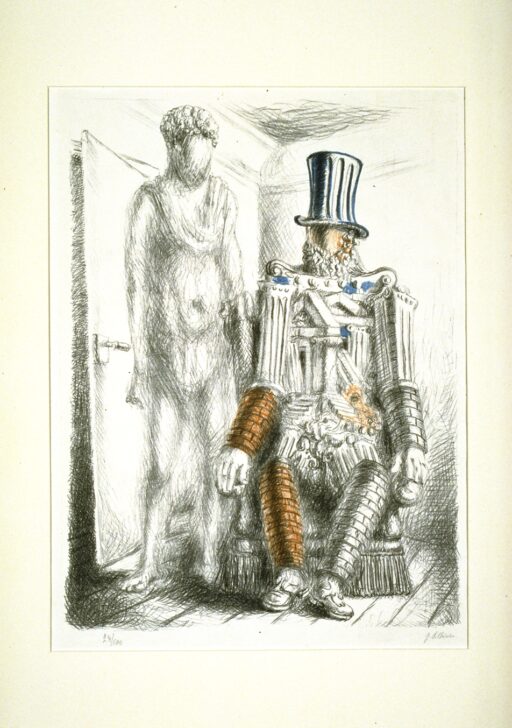Il ritorno del figliol prodigo
Giorgio de Chirico

Description
The theme of the return of the prodigal son (derived from the New Testament parable in which the son who has squandered his inheritance returns, repentant, to his father) recurs in de Chirico’s oeuvre. While the artist sometimes shows the son as a mannequin who struggles or submits, in this print, the son—more fully human than his father, whose body is encumbered by architectural elements—assumes a more neutral pose. In a large sense, what is evoked here is the meeting of the past and future in the present.
De Chirico’s own father was a Sicilian engineer who worked in Greece, where the artist grew up.
Label copy from exhibition "Dreamscapes: The Surrealist Impulse," August 22 - October 25, 1998
Subject Matter:
In this print, the Italian, Greek-born artist depicts the biblical parable of the prodigal son. With his brother Alberto Salvino, De Chirico co-created the artistic movement Scuola Metafisica in the nineteen-teens, a precursor to Surrealism, and this new form of painting relied heavily on the philosophy of Arthur Schopenhauer and Friedrich Nietzsche. Therefore, De Chirico utilized on proverbs and ancient and early-modern imagery in order to make work that simultaneously represented past, present and future. By the time this print series was created, De Chirico had also incorporated the Freudian ideas supported by the Surrealists into his work. Here, the father takes the form of an automaton made of classical architecture, temples and senates. The son, just having come in through the partly-open door, stands white and still, like the image of a classical sculpture. De Chricico often used this theme in his work, first in a painting in 1922 (Museo del Novecento); it likely had a certain autobiographical meaning to the artist.
The print is part of a larger series of works under the title of "Metamorphosis," referencing Ovid's epic poem.
Physical Description:
At the center of the print are two faceless figures. Located in the corner of room, near a door that is ajar, the one figure is standing barefoot and wearing draped clothing. The second figure sits to the left in cushioned chair; his legs and lower arms (below his elbows) are encased in brick facade; upper arms and body are columns. The seated figure wears a top hat that is outlined in blue and there are blue dots on their bodies. Bricks on the right side of body are brown. The print is signed (l.r.) "G. de Chirico" and numbered (l.l.) "28/100" in pencil.
Usage Rights:
If you are interested in using an image for a publication, please visit https://umma.umich.edu/request-image/ for more information and to fill out the online Image Rights and Reproductions Request Form.